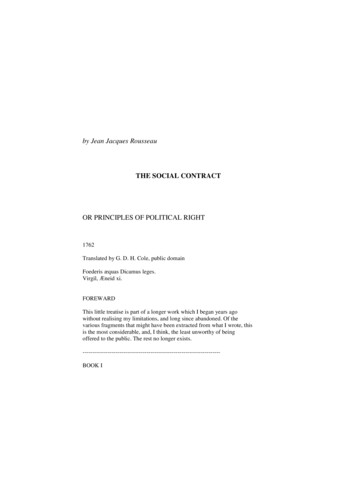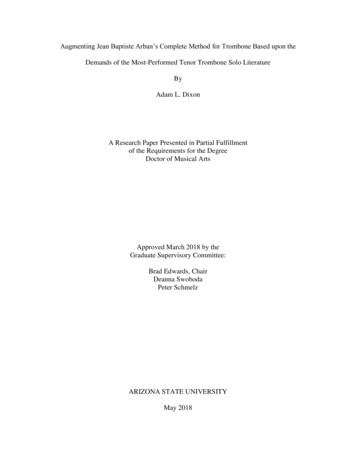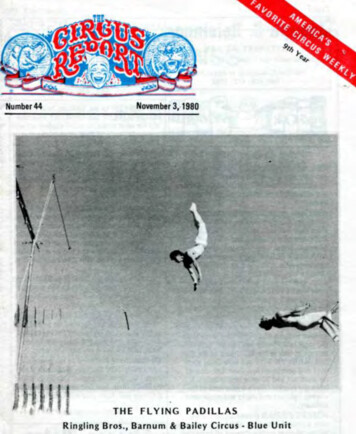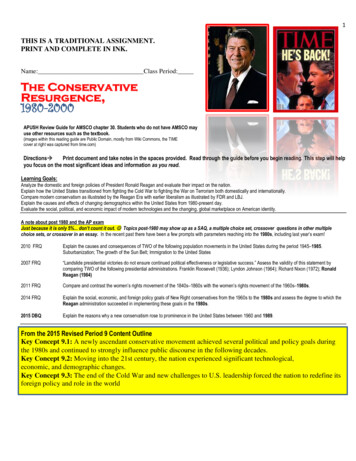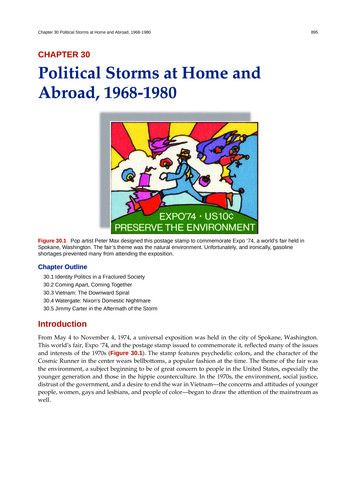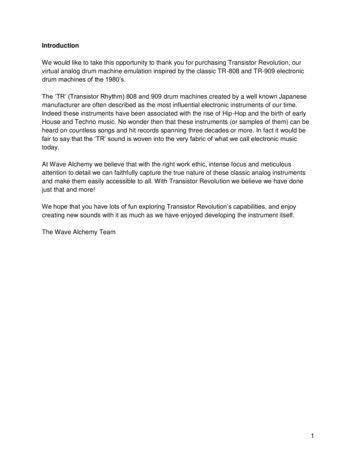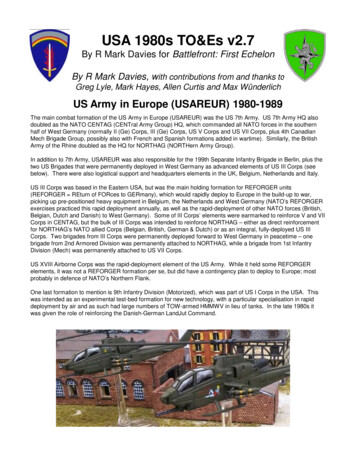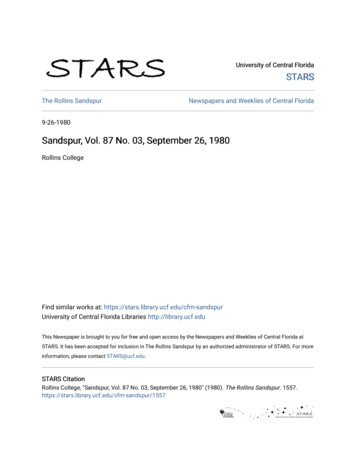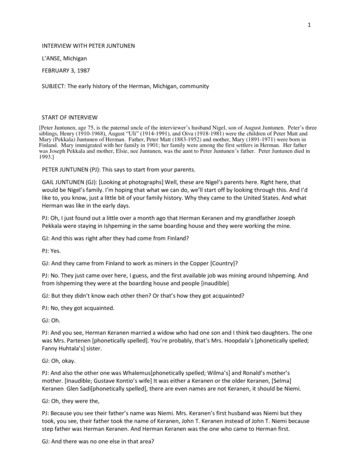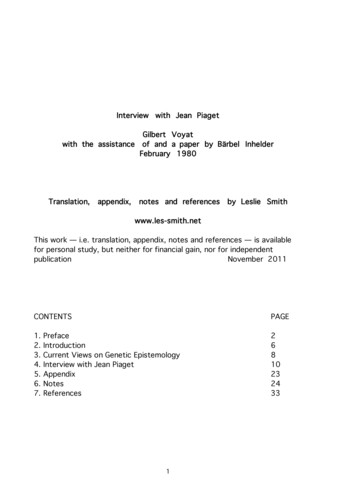
Transcription
Interview with Jean PiagetGilbert Voyatwith the assistance of and a paper by Bärbel InhelderFebruary 1980Translation,appendix,notes and referencesby Leslie Smithwww.les-smith.netThis work — i.e. translation, appendix, notes and references — is availablefor personal study, but neither for financial gain, nor for independentpublicationNovember troductionCurrent Views on Genetic EpistemologyInterview with Jean PiagetAppendixNotesReferences1
PrefaceLeslie SmithIn February 1980,1 Gilbert Voyat interviewed Jean Piaget with contributionsfrom Bärbel Inhelder. The interview in French was recorded in two ways, on atypescript and on film.The typescript is stored at the Jean Piaget Archives, based at Uni-Mail in theUniversity of Geneva. I located it serendipitiously during a research visit tothe Archives in October 2010. It is not clear whether its audio-transcriptionwas made at the interview itself, or later from the film. There was only onecopy and I do not know whether it was the first or final draft, but it had notbeen properly edited.The film is available as a DVD in the Library of the University of Geneva(Voyat, 1980). I located it through an online Library search in 2011. It wasmade by the Centre Audio-Visuel Universitaire, probably from an originalvideo-tape. It has an over-dubbed English translation, attributed to KlausSchultz (1935-2000) at the University of Massachussets. I do not knowwhether it was made from the audio-transcription used for the Frenchtypescript or made independently. The Library Catalogue shows that the filmwas intended for use in Inhelder's presentation at the next Meeting of theJean Piaget Society, i.e. its Tenth Meeting. Lynn Liben has confirmed thatthe progamme shows "there was a 'SPECIAL EVENT' that was held on Fridayevening May 30th, listed as 'Videotaped Interview with Jean Piaget andBärbel Inhelder' " (Liben, 2011). The programme indicated that the eventwould be introduced by Barbara Presseisen (2011) who has confirmed that"I introduced the video in 1980". Neither of the Genevans actually attendedthis presentation that was well received, as noted in a letter later in thesame year from Barbara to Bärbel: "over 200 Society members were at thepresentation and everyone was very stimulated by the ideas discussed in theinterview. We thought all three of you did very well" (in Liben 2011). A likelyexplanation for their absence was the decline in Piaget's health — he died inSeptember 1980.The interview has a dual importance. One is biographical: it was Piaget's finalinterview, supplementing several others (Piaget, 1968a, 1970, 1972,1972/1981, 1973, 1973/1981, 1977/1980) and complementing his finalpaper (1980/2006). The other is theoretical: its focus was on therelationships between the concepts and their applications that were centralto his constructivist studies, notably during the last decade of his work (seeTable 1 of Piaget, 1980/2006). These concepts have received scantattention, and two reasons for this may be noticed. Their relationships arecomplex and their interpretation difficult. One merit of the interview is its2
capacity to clarify and to facilitate their better comprehension. In theinterview, Voyat's questions were penetrating, leading Piaget to provideaccessible answers about the links between many of his main constructs.The other reason is that Piaget continued to re-analyse them right to theend. In a Postface, Piaget noted that he had delineated a "general skeletonthat was more or less obvious but still full of missing parts" (1976, p. 223),and no doubt that was why he regarded himself to be "one of the chiefrevisionist of Piaget" (1970/1983, p. 103). As usual, his chief colleaguefocused on a crucial feature of his modus operandi evident at thesymposium organised in 1976 to signal his official retirement from his chairat the University of Geneva. The symposium had its focus on Piaget's(1975/1985) book that was already being revised by its author in that"Piaget shows himself to be the least orthodox of the piagetians. Always inadvance with an idea, he had arranged for the circulation before thesymposium of his 'additional theses' " (Inhelder, 1976, p. 6).The DVD has three parts and lasts about one hour: Introduction in English by Gilbert Voyat (1937-1983) Paper in English by Bärbel Inhelder (1913-1997) Interview in French by Gilbert Voyat with Jean Piaget (1896-1980)and contributions by Inhelder with an over-dubbed English translationThe credits show the date to be March 1980. The typescript is datedFebruary 1980. A plausible explanation of the difference in date is that extratime was required to add the English translation and credits to the DVD.In preparing my translation, the typescript was my main source with the DVDused as supplementary evidence. I have augmented the typescript byremedying omissions detected in November by Jean-Jacques Ducret whohad access to the French recording, and these are marked thusJJD. There areseveral reasons for using the typescript in this way. Firstly, I made the firstdraft of my translation in Spring 2011 before gaining access to the DVDlater in 2011. Secondly, due to over-dubbing, it was impossible to listen tothe whole interview in French on the copy of the DVD that I obtained, and sothe typescript is the sole record of the words spoken in the interview.Thirdly, as far as I can tell, there is no text corresponding to the English auraltranslation. Nor is it clear whether it was made at the interview itself, orfrom the film, or from the audio-transcription for the typescript.The typescript differs from the DVD in several ways and my translationdiffers from both as follows:(i) I have corrected minor (spelling) errors in the typescript and these arelisted in the Appendix, marked in the text thus . I have also added Endnotes,3
marked in the text thus1. All the references are mine to related work with aview to clarifying what remains implicit in Piaget's laconic but insightfulanswers. This means that in what follows the Appendix, Endnotes andReferences are mine. Since Piaget was a prolific author with multiplepublications annually, references are shown with dual dates of French andEnglish texts to identify their chronology and to fix the reference. Myemendation of a standard (published) translation is identified by an asterickafter a relevant page number to the English publication — for example(Piaget, 1936/1953, p. 12*).(ii) Voyat's Introduction is included in English on the DVD but excluded fromthe typescript. I made an audio-transcription of his orally delivered text.Although he spoke in good English, his accent and the quality of therecording made it almost impossible to understand specific words. I haveannotated these as note 2.(iii) Inhelder's Paper is included in English both in the typescript and on theDVD. I have corrected minor (spelling) errors listed in the Appendix.(iv) Piaget's interview is included in the typescript in French, and on the DVDin French with an over-dubbed English translation. The latter made it veryhard to listen to exactly what was said in French. But it was possible tocompare my translation with the over-dubbed translation which I used tocheck two things. One was the authenticity of the typescript, i.e. whetherthe interview had taken place. The other concerned errors that I haddetected in the typescript — more on this next.(v) The DVD did not include all the exchanges in the typescript. Intranslating the typescript, I numbered these exchanges as Q1-Q35. The DVDexcluded exchanges Q33-Q35.(vi) There several minor differences between the DVD and typescript, usuallyre-statements on the DVD that I have omitted other than those shown inangle brackets thus . I have annotated substantive differences thus.29 Inthis example, the DVD records Piaget's answer to Q23 as referring to thework of "Temin and Baltimore"; the typescript refers only to the formerwhose name is misspelled — see note 29. See also notes 19, 28, and 31.AcknowledgementsMy thanks to Jean Blanquet, Katalin Haymoz, Barbara Presseisen, andAnastasia Tryphon for welcome assistance, and especially for theiressential contributions to Lynn Liben, who first to confirmed the interviewwas presented at the JPS conference in 1980, and to Jean-Jacques Ducret,4
who checked the French typescript and French audio-recording at crucialplaces in the interview. Any remaining errors or deficiencies are, of course,mine.5
IntroductionGilbert VoyatIt is a great pleasure for me to introduce Jean Piaget and Bärbel Inhelderwho represent an important direction and centre of ideas in geneticepistemology, the subject matter of this year's symposium of the JeanPiaget Society.2 My purpose is not to present Piaget's and Inhelder's multiplecontributions, but rather to make it clear that Piaget's main interest is anepistemological one. Above all, Piaget's is the theory of cognition; that is,Piaget is interested in the manner by which intellectual operations areconstructed, how they form, are stabilised in the child's mind, and fromwhere they derive. He is interested in that aspect of psychology because hismain intent is an epistemological one — the understanding of theconstruction of knowledge and the comprehension of its ontogenetics3 withthe history of science. Thus if Piaget can be said to be mainly interested incognition it is because his intent is not, as has often been stressed, apsychological one, but a philosophical one. For him, to take an example, thestudy of the construction of geometrical concepts in the child is geared atits evaluation from the point of view of the history of geometry as itunfolded over the centuries. In this context Piaget comes to simultaneouslyextract developmental data relevant to this area and to relate it with itsphylogenesis. He finds them parallel, which sheds light not only over thedevelopmental foundation of this paradigm3 area but also with itsepistemological grounds.Thus Piaget's intent is twofold. On the one hand, he wants to understandhow various concepts are constructed by the child and, on the other hand,he analyses their historical ramifications. In short, Piaget is a psychologistalmost by derivation, by derivation because he has at the core of hisenterprise the understanding of the nature of knowledge.The subject matter of today's interview deals with the on-going interestthat Piaget is actually pursuing, namely the problem of equilibration necessity phenocopy causality reasonThose have been on-going concepts which have come to light quite recentlyin Piaget's theory, but probably the most significant one is the concept ofreason which is at the core of the International Centre for GeneticEpistemology this year.46
From this point of view it may be of some interest, before beginning theinterview, to clarify what is meant by reason. The general purpose of thework is to determine the reason of an affirmation, in other words the "why"as opposed to the "how". It leads to the analysis of the meaning of actions,of operations and in general to the analysis of the structural characteristicsof the relationship between the operatory structures and the reason.In short, the general hypothesis is that there always exist a deep relationshipbetween the reasons, the "why", and the structures which means thatwhenever we find reasons, we will find structures. This is at least the basichypothesis that Piaget is actually pursuing.It is now time to let Bärbel Inhelder say a few words concerning thediscussion of today.7
Current Views on Genetic EpistemologyBärbel InhelderAs Piaget said on his 70th birthday,5 towards the end of a career, it's betterto change ones perspective than to be condemned to repeat oneself. Thework which he has accomplished since then with his team of youngresearchers and which at the age of 83, he still leads with the same oldenthusiasm and rigour, continues to explore new territory in the areas ofpsychological data, analytical models and the refinement of epistemologicalconceptions. We shall illustrate the creative dialectics inherent in hisscientific work by means of three examples.(1) The first relates to causality. In the early seventies, a vast amount ofresearch was dedicated to the understanding of causality, most of which isstill in press.6 Piaget has been interested in children's spontaneous interpretation of physical phenomena since his early books which I had thehonour of writing with him — The Child's Conception of Quantities — withthe subtitle Conservation and Atomism. We were interested in atomism asan explanatory model in physics and in its development. Nowadays Piagetshows that in explaining reality one attributes an operatory model to thisreality, this model being constituted by the subject during his cognitivedevelopment. If models are adequate to account for physical reality, it's because they're constituted in interaction with that reality. This is apowerful demonstration of a truly interactionist conception of knowledge.The physicist Garcia has shown that analogies exist between themechanisms underlying the historical progress of scientific thought at leastup to the time of Newton and cognitive development in children.8(2) The second example is that of the logical thought of the child — aproblem which has been one of Piaget's constant preoccupations from thebeginning and which proved much richer than was first thought.Piaget has always maintained that research which only confirms what oneexpects is without interest and that successful research comes up againstunforeseen obstacles and new problems. For example, when Piaget beganhis research on the logic of the child, he thought he would find only a palereflexion of the logic of logicians. In fact, in analysing the reasoning of 7-10year old children Piaget and his collaborators were led to discover the lawsof an elementary structure, which is widely used by biologists and which hecalled the logic of opera
check two things. One was the authenticity of the typescript, i.e. whether the interview had taken place. The other concerned errors that I had detected in the typescript — more on this next. (v) The DVD did not include all the exchanges in the typescript. In translating the typescript, I numbered these exchanges as Q1-Q35. The DVD
